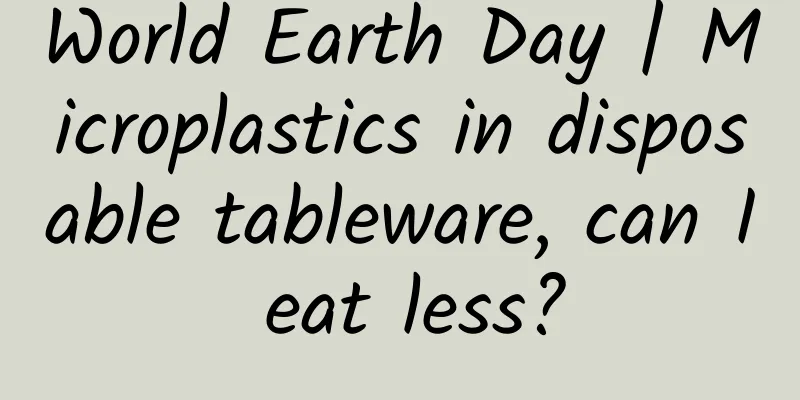World Earth Day | Microplastics in disposable tableware, can I eat less?

|
"Recently, the New England Journal of Medicine (NEJM) published a study [1] that revealed a possible correlation between microplastics and the risk of death from human diseases. The study followed up 257 patients who had undergone carotid endarterectomy for an average of 34 months and found polyethylene in the carotid plaques removed from 58.4% of the patients. Polyvinyl chloride was also found in the plaques of 12.1% of the patients. The particle diameters of these plastics were generally below 200 nanometers. Through further analysis and statistics, it is not difficult to conclude that compared with patients without microplastics in their plaques, patients with plastic fragments in their plaques had a 3.53 times higher risk of heart disease, stroke, or all-cause death."
Image | New England Journal of Medicine This study reminds us that our understanding of the potential hazards of microplastics needs to be strengthened. 1. Where do microplastics come from? Microplastics refer to plastic particles with a diameter of no more than 5 mm. Some microplastics are byproducts of daily chemical products. The most common are plastic microbeads added to scrubs and toothpastes as abrasives, but they only account for less than 2% of the total microplastics. A larger portion of microplastics is produced by the breakage and wear of plastic products[2]. For example, microplastic fibers fall off during the washing of synthetic clothing; microplastic particles produced by the wear of synthetic rubber tires; and microplastics from the peeling of public facilities such as road signs and ships or the peeling of paint. Picture | intelligentliving, reddit, franswillemblok Microplastics come from a wide range of sources and are found almost everywhere. They may float in the air and be inhaled by animals or humans, flow into the ocean along streams, or reach the tops of snow-capped mountains with rainfall. Currently, researchers have found large amounts of microplastics not only in the soil and waters of densely populated areas, but also in remote environments such as the North and South Poles and the deep sea. In addition, the concentration of microplastics in the surface waters of the ocean appears to have increased significantly over the past four decades[3].
Figure | "Crazy Microplastics" Perhaps what you are most concerned about is how microplastics enter the human body? There are three main ways that microplastics enter the human body: through food ingestion, inhalation through the air, and contact with human skin through tiny particles in products, textiles or dust. Intake through food Ingestion through food is considered the main way for humans to be exposed to microplastics. A study published in Environmental Science and Technology by the University of Victoria in Canada revealed that based on the dietary habits of Americans (including common foods such as seafood, sugar, salt, honey, alcohol, and tap and bottled water), a person may ingest 74,000 to 121,000 microplastic particles each year[4]. In addition, a research report in the journal Environmental Science also showed that microplastics have been detected in a variety of foods such as mussels, fish, salt and sugar[5]. In a research review published in Environmental Science, the University of Elgar in Indonesia emphasized that food packaging is also an important source of microplastics, including plastic packaging, disposable plastic containers, disposable paper cups, disposable tea bags, and polypropylene (PP) milk bottles [6]. Some studies have shown that people who only meet the recommended intake through bottled water may ingest an additional 90,000 microplastics per year, while people who only drink tap water may ingest 4,000 microplastics [7]. Another study found that on average, bottled water contains about 240,000 detectable plastic particles per liter, which is 10 to 100 times higher than earlier counts based on larger plastic particles [8]. Inhaled with air Microplastics can be released into the air from a variety of sources, including synthetic textiles, wear and tear of materials (e.g., car tires, buildings), and resuspension of microplastics on surfaces. Researchers at Aalborg University in Denmark published a study in the journal Nature stating that a person may inhale 16.2 plastic fragments per hour from their clothing and air, and ingest approximately 3,000 microplastic particles per week, which is equivalent to eating a credit card-sized piece of plastic per week[9]. In addition, microplastic fibers have also been detected in human lung biopsies (including cancer biopsies)[10]. Contact with human skin through particles in products, textiles or dust Although it has been speculated that nanoplastics (<100 nm) can pass through the human skin barrier[11], there is still insufficient research to prove that skin contact with microplastics is harmful to humans. However, it is undeniable that many items we use in our daily lives release microplastics directly or indirectly. In a study published in Environmental Science and Technology, researchers from Nanjing University estimated that a pair of contact lenses would release 90,698 microplastic particles during one year of wear[12].
Figure | mdpi It should be pointed out that the “intake” mentioned here is an estimate and cannot be equated with the amount absorbed by the human body. After all, some studies have found that human feces also contain microplastics [14] (laughs). However, since multiple studies have found the presence of microplastics in the human body, there is no doubt that we “eat” some microplastics. 2. Big shock, risks from head to toe In fact, many scientists have discovered earlier that microplastics may pose health risks to humans. Microplastics may affect human metabolic activity Several studies have shown that microplastics can affect the metabolic activities of animals. For example, microplastics can reduce the feeding activity of marine worms, crabs, and clams[14]; they can also reduce the activity of digestive enzymes in fish, affecting their digestive capacity and ultimately leading to a decrease in the fish’s predatory performance[13]. Microplastics may affect the human digestive system Once microplastics enter the human gastrointestinal system, they affect gastrointestinal motility and threaten human health. At the same time, some microplastics can be broken down into nanoplastics, which then interact with intestinal microorganisms and cross intestinal epithelial cells to enter the circulatory system. For patients with intestinal diseases, the increased tissue permeability caused by inflammatory infection will also significantly increase the transport rate of microplastics [16]. Microplastics may affect the human respiratory system When people breathe in an environment exposed to microplastics, tiny plastic particles may be inhaled into the lungs. Studies have shown that after these microplastics enter the human body, they will have health effects on the human respiratory system. Different monomer structures have different effects on human health. Excessive intake of polyvinyl chloride (PVC), polystyrene (PS) and polytetrafluoroethylene (PTFE) has been shown to cause symptoms of respiratory diseases, skin diseases, or adverse symptoms such as indigestion, headache, dizziness, and nausea. In addition, representative microplastic substances such as polypropylene (PP) and polyethylene (PE) can persist in the lungs [17]. Microplastics may affect the human circulatory system The discovery of microplastics in human blood is also particularly critical. A study published in Environment International found that microplastic particles were detected in the blood of 77% of healthy volunteers. These particles can flow into various tissues and organs of the human body through the blood, posing potential hazards to the human body[18]. It is worth noting that, in addition to directly detecting microplastics in the human body, the description of their biological toxicity or causing human diseases is based on animal experiments or scientific inferences. There is no direct research to prove that microplastics can cause diseases. In other words, due to the short research period and the need to comply with research ethics, scientists can only reasonably infer that microplastics can cause diseases, but have not found any solid evidence. The study at the beginning of the article contributed an important conclusion: based on actual human data, it was determined that microplastics are correlated with the risk of death from human diseases. Although it cannot be said that there is a causal relationship between microplastics and cardiovascular and cerebrovascular diseases, the risks of long-term exposure to microplastic environments need to be taken seriously! 3. Finding a balance, how should we do it? At this point, even if we comfort everyone that "there is no solid evidence", we are already very anxious. It is not terrible to have problems, but it is terrible to have problems that are difficult to solve, and this is the case with plastics. Plastic products have made people's lives so convenient, and they are deeply tied to human society. Even if we are willing to give up convenience for the sake of health and the environment, it is actually difficult to completely stop using plastic. What should we do? 1. Refuse to use high-risk plastic products Try to avoid using polyvinyl chloride (PVC) and oxidatively degradable plastic products. There are differences between plastics. There are relatively safe and stable plastic products, and there are also "toxic plastics", such as polyvinyl chloride (PVC). Its basic monomer is vinyl chloride, which is extremely toxic and unstable, so a large amount of additives are needed to stabilize it. But even in its final stable form, PVC is still not very stable and can easily release additives, which is almost impossible to avoid [19]. In addition, oxidatively degradable plastics, which are often misunderstood as environmentally friendly plastics, are actually non-degradable plastics (such as polypropylene and polypropylene) that are made by adding catalysts to them, causing them to oxidize and break down faster under the interaction of light, heat, and oxygen. However, their products are plastic fragments/microplastics, plasticizers, dyes, and other additives. In addition to causing pollution to the natural environment, these can also enter the human body and pose a threat to human health [20][21][22]. There have been calls in the international community to restrict the production and use of polyvinyl chloride (PVC) and oxidatively degradable plastics[23-24]. Hainan Province[25], Taiwan Province[26], the Hong Kong Special Administrative Region[27], South Korea[28], Iceland[29] and other countries have imposed restrictions on them to varying degrees. 2. Limit the use of plastic products and use as few disposable items as possible In addition to rejecting dangerous plastic products, as ordinary consumers, we can also choose to use plastic products with caution. After all, purchasing and using are our important votes. Replace disposable plastic products with safer and reusable stainless steel, glass, ceramic, cotton products, etc., especially containers that come into direct contact with food. If you really need to use plastic containers, give priority to polypropylene (PP) that supports reuse, and high-quality silicone products can also be considered. Here, reusable does not mean repeatedly using disposable items, not only because disposable plastic waste is one of the reasons for the rapid growth of plastic waste, but also because disposable products are often of poor quality, and the release of microplastics and additives is even more uncontrolled. (Click here for details). 3. Eat less microplastics, you can also do this We can also work harder at the entry point and do the following to continue to make it more difficult for microplastics to enter our bodies. At home, try to prepare drinking water by filtering or boiling it. After boiling hard water, 80% of polystyrene, polyethylene and polypropylene microplastic particles with a size between 0.1 and 150 microns can settle as sediment. Further filtration can reduce their intake. Even in soft water, about 25% of microplastic particles can still be precipitated after boiling the water[30]. Do not put plastic bags in bowls to hold hot food, and avoid using plastic containers to heat food in the microwave. Studies have shown that microwave heating leads to the highest release of microplastics and nanoplastics in food compared to other usage scenarios such as refrigeration or room temperature storage[31]. Eat less processed foods, as they are packaged in layers and are at higher risk of being contaminated by microplastics. The interior of canned foods is generally coated with epoxy resin containing bisphenol A, which may seep into the food[32]. Eat less seafood offal, mussels, and sea salt. Plastics account for up to 85% of marine debris. When plastics decompose in the marine environment, they leak microplastics, toxic chemicals, etc. into the water and sediments, and eventually transfer to the marine food chain [33]. Through the above measures, we can greatly reduce our exposure to harmful plastic environments and reduce our intake of microplastics. However, if we want to be more environmentally friendly and feel more at ease, more forces need to be added. For example, plastic production companies at the upstream of consumption should stop the production and use of harmful plastics from the source; daily chemical products, food companies, etc. should choose safe reusable packaging instead of disposable plastic packaging; departments related to plastic pollution control should scientifically legislate and strictly supervise. As consumers, in addition to actively reducing the use of disposable plastic products, we can also actively feedback our needs to companies or governments, promote the whole society to try reusable consumption models, and reduce the risk of exposure to microplastics. References [1] Marfella, R., Pratichizzo, F., Sardu, C., Fulgenzi, G., Graciotti, L., Spadoni, T., ... & Paolisso, G. (2024). Microplastics and nanoplastics in atheros and cardiovascular events. New England Journal of Medicine, 390(10), 900-910. [2] Ju Maowei, Dang Chao, Zhang Weiwei, Wang Ying, Wang Juying. Marine microplastics are everywhere[J]. World Environment, 2020, 183(2): 24-27. [3] UNEP.Microplastics[R].2019:4.brochure-microplastics.pdf (unep.org). [4] Ziani, Khaled, et al. "Microplastics: a real global threat for environment and food safety: a state of the art review." Nutrients 15.3 (2023): 617. [5]Prata, Joana Correia, et al. "Environmental exposure to microplastics: An overview on possible human health effects." Science of the total environment 702 (2020): 134455. [6] Lehel, József, and Sadhbh Murphy. "Microplastics in the food chain: food safety and environmental aspects." Reviews of Environmental Contamination and Toxicology Volume 259 (2021): 1-49. [7] Cox, Kieran D., et al. "Human consumption of microplastics." Environmental science & technology 53.12 (2019): 7068-7074. [8] Qian, Naixin, et al. "Rapid single-particle chemical imaging of nanoplastics by SRS microscopy." Proceedings of the National Academy of Sciences 121.3 (2024): e2300582121. [9] Vianello, Alvise, et al. "Simulating human exposure to indoor airborne microplastics using a Breathing Thermal Manikin." Scientific reports 9.1 (2019): 8670. [10] Pauly, John L., et al. "Inhaled cellulosic and plastic fibers found in human lung tissue." Cancer epidemiology, biomarkers & prevention: a publication of the American Association for Cancer Research, cosponsored by the American Society of Preventive Oncology 7.5 (1998): 419-428. [11] Revel, Messika, Amélie Châtel, and Catherine Mouneyrac. "Micro (nano) plastics: a threat to human health?." Current Opinion in Environmental Science & Health 1 (2018): 17-23. [12] Liu, Yuxuan, et al. "High-content screening discovers microplastics released by contact lenses under sunlight." Environmental Science & Technology 57.23 (2023): 8506-8513. [13] ROBBIE GONZALEZ. Nine types of plastic particles detected in human feces for the first time. Has white pollution finally invaded your body? [OL]. https://mp.weixin.qq.com/s/XTJ1zq74jxjReCFQzmfB_A, 2018-10-26. [14] Xu, XY, et al. "Microplastic ingestion reduces energy intake in the clam Atactodea striata." Marine Pollution Bulletin 124.2 (2017): 798-802. [15] Wen, B., Zhang, N., Jin, S.-R., Chen, Z.-Z., Gao, J.-Z., Liu, Y., Liu, H.-P., Xu, Z., 2018. Microplastics have a more profound impact than elevated temperatures on the predatory performance, digestion and energy metabolism of an Amazonian cichlid. Aquat. Toxicol. 195, 67–76. [16] Su Yaping, Li Ruiling, Li Bo, et al. Research progress on the effects of microplastics on human health[J]. Journal of Henan University (Medical Edition), 2023, 42(03): 157-162. [17] Zhang Simeng, Cha Jin, Meng Wei, et al. Microplastics in the environment and their impact on human health[J]. China Plastics, 2019, 33(04): 81-88. [18] Leslie, Heather A., et al. "Discovery and quantification of plastic particle pollution in human blood." Environment international 163 (2022): 107199. [19] Jay Sinha, Chantal Plamondon. A guide to a healthy life without plastic: Is not using plastic for health? Regarding environmental protection, can I just do a good job of recycling? Solve your plastic-free problems! [M]. Guangxian Publishing, 2019-08-14. [20] Yang Jie, Li Lianzhen, Zhou Qian, Li Ruijie, Tu Chen, Luo Yongming. Microplastic pollution in soil environment: sources, processes and risks[J]. Acta Pedologica Sinica, 2021, 58(02): 281-298. [21] Prata J C. Airborne microplastics: Consequences to human health [J]. Environmental Pollution, 2018, 234: 115-126. [22] Eunomia. (2016). The Impact of the Use of “Oxo-degradable” Plastic on the Environment. [23] PHYS. US begins review that could eventually lead to PVC ban. Available at: https://phys.org/news/2023-12-pvc.html [24] HEAL. Inforgraphic: The EU must ban PCA! Availiable: https://www.env-health.org/infographic-the-eu-must-ban-pvc/ [25] National Development and Reform Commission of the People’s Republic of China. Hainan Province issued the “Supplementary Implementation Plan for the Comprehensive Prohibition of the Production, Sale and Use of Disposable Non-degradable Plastic Products in Hainan Province” and the “Regulations on the Prohibition of Disposable Non-degradable Plastic Products in Hainan Special Economic Zone” [Z]. 2020-09-15. [26] Environmental Protection Administration press release. Environmental Protection Administration bans the manufacture, import and sale of food packaging containing PVC from July 1, 2023 [OL]. https://enews.moenv.gov.tw/page/3b3c62c78849f32f/197a6f06-c436-4720-82b3-a58c6e849a69, 2022-4-29. [27] Legislative Council of the Hong Kong Special Administrative Region. "Product Environmental Responsibility (Amendment) Ordinance 2023". https://www.legco.gov.hk/yr2023/chinese/ord/2023ord027-e.pdf. 2023-10-26. [28] Pearly Neo.No colour, no PVC: South Korea bans hard-to-recycle plastic materials for F&B packaging[OL].https://www.foodnavigator-asia.com/Article/2020/01/31/No-colour-no-PVC-South-Korea-bans-hard-to-recycle-plastic-materials-for-FB-packaging,31-01-2020. [29] Jelena Ćirić.Iceland Bans Single-Use Plastics Starting in 2021[OL].https://www.icelandreview.com/society/iceland-bans-single-use-plastics-starting-in-2021/2020-07-06. [30] Yu Z, Wang JJ, Liu LY, et al. Drinking Boiled Tap Water Reduces Human Intake of Nanoplastics and Microplastics[J]. Environmental Science & Technology Letters, 2024. [31] Environ. Sci. Technol. 2023, 57, 26, 9782–9792 Publication Date: June 21, 2023. https://doi.org/10.1021/acs.est.3c01942. [32] National Institute of Environmental Science. Biophenol A (BPA). https://www.niehs.nih.gov/health/topics/agents/sya-bpa [33] UNEP.From Pollution to Solution:A Global Assessment of Marine Litter and Plastic Pollution[R].2021. -End- Edit: Get rid of plastic |
>>: Is liver function normal? You still need these 3 tests
Recommend
Popular Science | Learn about the important vitamin for the human body - Vitamin K
Vitamins are an essential topic when it comes to ...
How much hcg will cause the embryo to die in ectopic pregnancy
When a woman becomes pregnant, her body's hor...
What causes frequent urinary incontinence in women?
Adult women will feel very embarrassed if they ha...
Standards for uterine recovery after induced labor
There is no standard for uterine repair after ind...
Lower abdominal pain in late pregnancy
Many women will insist on going to work during pr...
The best age for accessory breast removal
Regardless of the impact of underarm accessory br...
Morning sickness is actually fetal arrest
Women will have a lot of concerns after they beco...
What causes vaginal bleeding in elderly women?
Most of the elderly women have already gone throu...
Pregnant woman gets up too fast and the fetus fractures
There are many things that women need to pay atte...
Is it normal to have back pain during menstruation?
Women have their periods every month, and their b...
What should women do if they have kidney deficiency and yin deficiency?
Kidney deficiency and Yin deficiency seem to be s...
Red spots on breasts
Breasts are a very important sexual organ for wom...
What are the effects of breast massage
Breasts can be enlarged through breast massage. T...
When should shark oil be taken? How to take shark oil?
Sharks belong to the class Chondrichthyes of the ...
Is there false or true astigmatism? How should astigmatism be treated?
Friends with myopia must have heard of the word a...









